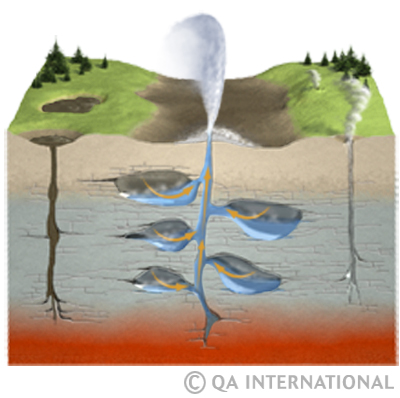
Geysers: when the Earth spits water
When rainwater falls to Earth, it seeps into cracks in the rocks and trickles deep underground. In some places, hot magma from Earth’s mantle heats the water up to almost 400°F (200°C). The heated rainwater then rises back up to the surface and emerges as vapor or water through hot springs, mud pools, or geysers. Of all these phenomena that occur in volcanic areas, geysers are the most spectacular. The word “geyser” comes from an Icelandic word that means “gushing spray”. Geysers can shoot enormous jets of steam and hot water high into the air. Most of these “water volcanoes” are located in areas where magma is close to Earth’s surface. Geysers are mainly found in Iceland, New Zealand, and the United States, whose famous Yellowstone National Park is home to more than 10,000 geysers!
How geysers are formed
When rainwater seeps into the ground, it may collect in an underground cavity, called a reservoir, located near a pocket of hot magma. The water heats up and gradually turns into steam. As the pressure builds, the steam is forced back up to the surface where it shoots out in powerful jets. The geyser stops spouting when the underground cavity no longer contains enough water or steam. The phenomenon may last anywhere from a few minutes to a few hours. Over time, the reservoir gradually fills with water again and the process is repeated. The water accumulates in underground reservoirs. The jets of steam and water coming out of geysers can reach heights of more than 300 feet (100 m). The tallest geyser active today is located in Yellowstone National Park. Known as “Steamboat,” its jets skyrocket more than 410 feet (125 m) into the air.

As regular as clockwork
Yellowstone National Park’s “Old Faithful” is the most famous geyser in the world. Good weather or bad, Old Faithful can be counted on to shoot up to 10,000 gallons (38,000 l) of water into the air over a four-minute period. It’s a performance that has been repeated faithfully, about once an hour, for more than 200 years!
Volcanic landscapes
Volcanic activity produces a variety of phenomena besides geysers. When underground water and gases are heated by magma, they may shoot up to the surface as mud, water, or smoke, creating some very strange landscapes:
- Gases rise to the surface and form bubbling muddy pools of decomposed volcanic rock particles and water mixed together.
- Water seeping into the ground near a volcanic zone is heated up by the surrounding rock. When the water rises back up to the surface, it is extremely hot. Many hot springs are thought by some people to have healing powers in the treatment of certain illnesses.
- Fumaroles are vents on the slopes of volcanoes that allow gases to escape. The gases emerge as a column of smoke, as if out of a chimney. The sulfur in the gases makes them smell like rotten eggs.
Also see:
In the Visual Dictionary:
In the encyclopedic capsules :
- Earth: a rocky planet
- Minerals and precious stones: Earth’s jewels
- Mountains: the top of the world
- Our knowledge of geologic time
- Deserts: where Mother Nature is queen
- The deserts of the Americas and Africa
- Earth—the exceptional blue planet
- The shoreline: between land and sea
- Cyclones, monsters of the ocean
- Configuration of the continents
In the ikonet games:
- Put it in its place!:




